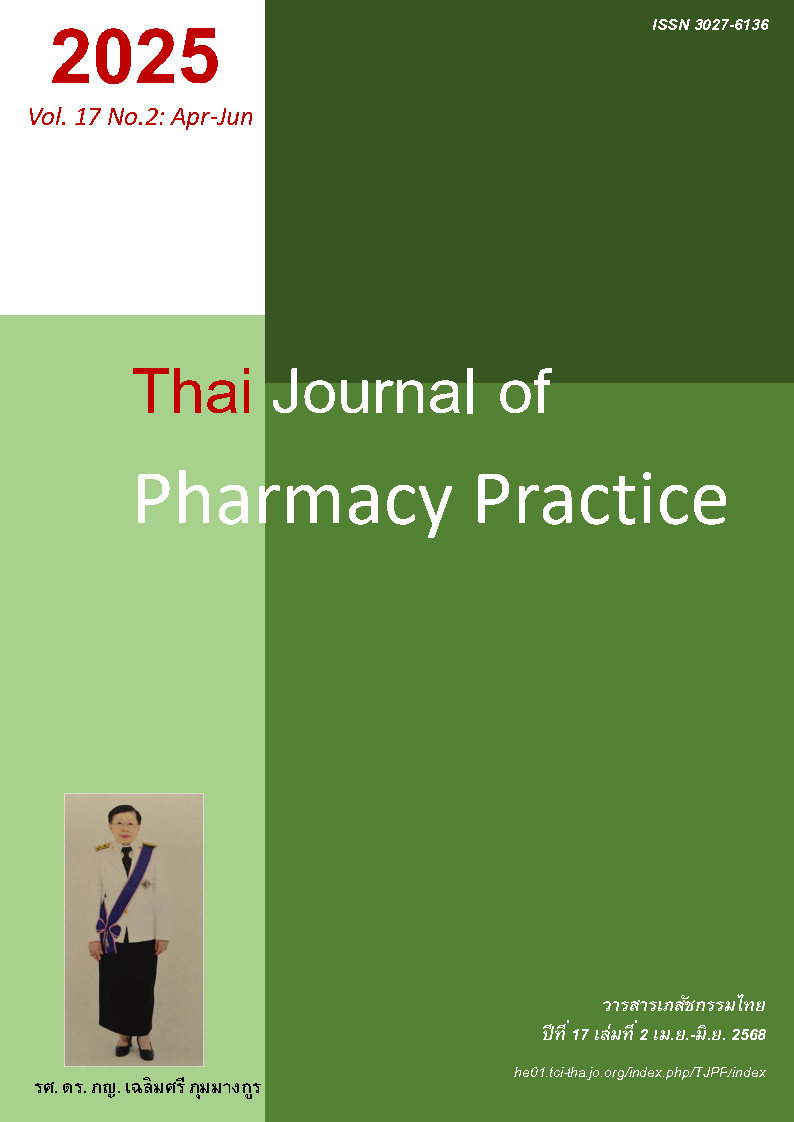สิ่งท้าทายต่อการคงอยู่ในระบบของผู้บำบัดด้วยเมทาโดนระยะยาว ในพื้นที่ทุรกันดารแห่งหนึ่งทางภาคเหนือของประเทศไทย
Main Article Content
บทคัดย่อ
วัตถุประสงค์: เพื่อศึกษาสิ่งท้าทายต่อการคงอยู่ในระบบบำบัดด้วยเมทาโดนในระยะยาว ในมุมมองของผู้บำบัดที่อาศัยในพื้นที่ทุรกันดารของอำเภอเวียงแหง จังหวัดเชียงใหม่ วิธีการ: การศึกษาสัมภาษณ์เชิงลึกผู้บำบัดยาเสพติดด้วยเมทาโดน 11 รายและผู้นำชุมชน 3 รายในอำเภอเวียงแหง จังหวัดเชียงใหม่ที่ได้รับการคัดเลือกแบบจำเพาะเจาะจง ในช่วงวันที่ 1 สิงหาคม 2565 – 30 เมษายน 2566 แนวคำถามสำหรับการสัมภาษณ์กึ่งโครงสร้างพัฒนาขึ้นโดยใช้ Risk Environment Framework, Health Belief Model และ Shared Decision Making Model การวิเคราะห์ข้อมูลใช้การวิเคราะห์เนื้อหา ผลการศึกษา: ปัจจัยที่เป็นอุปสรรคต่อการคงอยู่ในระบบของผู้บำบัดด้วยเมทาโดนระยะยาวที่สำคัญ คือ บริบทของพื้นที่อำเภอเวียงแหง ได้แก่ การมีภูมิประเทศเป็นป่าเขาติดประเทศพม่าซึ่งเป็นเส้นทางการเดินทางของยาเสพติด ทำให้คนเข้าถึงยาเสพติดได้ง่าย การคมนาคมที่ยากลำบากทำให้ผู้บำบัดไม่สามารถรับยาได้ตามนัด การจำกัดปริมาณการจ่ายยาเมทาโดนทำให้ต้องมารับบริการบ่อยครั้ง จึงเป็นอุปสรรคสำหรับผู้บำบัดส่วนใหญ่ โดยเฉพาะผู้มีรายได้น้อยที่ค่าใช้จ่ายในการเดินทางมาบำบัดกระทบต่อความเป็นอยู่ การขาดการเข้าถึงการศึกษาทำให้ประชาชนในอดีตไม่รู้ว่ายาเสพติดนั้นผิดกฎหมาย รวมถึงประชากรส่วนใหญ่เป็นกลุ่มชาติพันธุ์ที่มีภาษาและวัฒนธรรมเป็นของตนเอง จึงยากต่อการสื่อสารเพื่อการบำบัด ถ้ามีคนในครอบครัวที่สนับสนุนและมีคนในชุมชนที่เป็นชาติพันธุ์เดียวกันที่คอยเป็นผู้ประสานงานในการบำบัดจะทำให้ความร่วมมือดีขึ้น สรุป: บริบทความทุรกันดารของพื้นที่อำเภอเวียงแหงส่งผลต่อการคงอยู่ในระบบการบำบัดด้วยเมทาโดนในระยะยาว หลายปัจจัยที่เกี่ยวข้องทั้งเป็นอุปสรรคและสนับสนุนการบำบัดด้วยเมทาโดน ทำให้การบำบัดมีความซับซ้อนและต่างจากพื้นที่อื่น ดังนั้นรูปแบบการให้บริการควรคำนึงถึงบริบทพื้นที่ และบูรณาการกับภาคส่วนอื่นที่เกี่ยวข้อง
Article Details

This work is licensed under a Creative Commons Attribution-NonCommercial-NoDerivatives 4.0 International License.
ผลการวิจัยและความคิดเห็นที่ปรากฏในบทความถือเป็นความคิดเห็นและอยู่ในความรับผิดชอบของผู้นิพนธ์ มิใช่ความเห็นหรือความรับผิดชอบของกองบรรณาธิการ หรือคณะเภสัชศาสตร์ มหาวิทยาลัยสงขลานครินทร์ ทั้งนี้ไม่รวมความผิดพลาดอันเกิดจากการพิมพ์ บทความที่ได้รับการเผยแพร่โดยวารสารเภสัชกรรมไทยถือเป็นสิทธิ์ของวารสารฯ
References
Azadfard M, Huecker M, Leaming J. Opioid addiction [online]. 2021 [cited 26 July 2021]. Available from: www.statpearls.com/articlelibrary/viewarticle/26212/?utm_source=pubmed&utm_campaign=CME&utm_content=26212
Verachai V, Pattrakorn A, Lukkhanapichonshut L, Chuchareon P, Tongpanich C, Wittayanukooonluck A, et al. Drugs and addictive substances. Nonthaburi: Department of Medical Services, Ministry of Public Health; 2014.
Hayashi K, Ti L, Fairbairn N, Kaplan K, Suwannawong P, Wood E, et al. Drug-related harm among people who inject drugs in Thailand: summary findings from the Mitsampan Community Research Project. Harm Reduction J 2013; 10: 2-9.
Gowing, L R, Hickman M, Degenhardt L. Mitigating the risk of HIV infection with opioid substitution treatment. Bull World Health Organ 2013, 91: 148-9.
Duangrithi D, Cheewinaphirak N, Jansiriyanan R, Phetnil T. Improvement of methadone maintenance treatment guideline for opioid dependency. Srinagarind Medical Journal. 2021; 36: 119-25.
Mahathep P, Thananarapong J. Factors that affect treatment outcome of opioid use disorder with community participation in Maeteang, Chiangmai province. Thammasat University Hospital Journal Online. 2018; 3: 28-38.
Pattrakorn A, Sumrantiwawan W, Boonchaipanichwat thana S, Lapini T, Ngarmkachornwiwat A, Ukaranun W, et al. Standards for long-term methadone therapy in Thailand. Bangkok: Chulalongkorn University Printing House; 2013.
Suwanmajo S, Duangrithi D, Komkla N, Phattanachot W, Sathaporn U. Predictors – one year retention methadone maintenance therapy at princess mother institute on drug abuse treatment. Journal of the Department of Medical Services. 2019; 44: 119-24.
Zhou K, Li H, Wei X, Li X, Zhuang G. Medication adherence in patients undergoing methadone maintenance treatment in Xi’an, China. J Addict Med 2017; 11: 28-33.
Navidian A, Kermansaravi F, Tabas EE, Saeedinezhad F. Efficacy of group motivational interviewing in the degree of drug craving in the addicts under the methadone maintenance treat- ment (MMT) in South East of Iran. Arch Psychiatr Nurs 2016; 30: 144-9.
Darker CD, Ho J, Kelly G, Whiston L, Barry J. Demographic and clinical factors predicting retention in methadone maintenance: results from an Irish cohort. Ir J Med Sci. 2016; 185: 433-41.
Mertens JR, Weisner CM. Predictors of substance abuse treatment retention among women and men in an HMO. Alcohol Clin Exp Res. 2000; 24: 1525–33.
Mancino M, Curran G, Han X, Allee E, Humphreys K, Booth BM. Predictors of attrition from a national sample of methadone maintenance patients. Am J Drug Alcohol Abuse 2010; 36: 155–60.
Khampang R, Assanangkornchai S, Teerawatta nanon Y. Perceived barriers to utilise methadone maintenance therapy among male injection drug users in rural areas of Southern Thailand. Drug Alcohol Rev 2015; 34: 645-53.
Hayashi K, Ti L, Ayutthaya P, Suwannawong P, Kaplan K, Small W et al. Barriers to retention in methadone maintenance therapy among people who inject drugs in Bangkok, Thailand: a mixed-methods study. Harm Reduct J 2017; 14: 63. doi: 10.1186/s1 2954-017-0189-3.
Hawangchu D, Chamratrithirong A, Phuengsamran D. Stigmatization phenomena among people who use groups: a case study from community-based MMT Clinics. Journal of Public Health 2017; 47: 276-88.
Highland Research and Development Institute. Royal project-style highland development project area to solve specific area problems: Highland research and development institute [online]. 2021 [cited Jul 31, 2021]. Available from: www.hrdi.or.th/ AreaOfOperations/SolveOpium
Sarasvita R, Tonkin A, Utomo B, Ali R. Predictive factors for treatment retention in methadone programs in Indonesia. J Subst Abuse Treat 2012; 42: 239–46.
Peles E, Linzy S, Kreek M, Adelson M. One-year and cumulative retention as predictors of success in methadone maintenance treatment: a comparison of two clinics in the United States and Israel. J Addict Dis 2008; 27: 11-25.
Nimsakul K, Suwannaprom P, Suttajit S. Complexity of implementing harm reduction services in community hospitals: A two-phase qualitative study. Thai J Pharm Sci 2022; 46: 324-34.
Rhodes T. The ‘risk environment’: a framework for understanding and reducing drug-related harm. Int J Drug Policy 2002; 13: 85–94.
Becker M. The health belief model and sick role behavior. Health Ed Monograph 1974; 2: 410-9.
Marshall T, Hancock M, Kinnard E, Olson K, Abba-Aji A, Rittenbach K et al. Treatment options and shared decision-making in the treatment of opioid use disorder: A scoping review. J Subst Abuse Treat 2022; 135: 108646.
Stiggelbout AM, Pieterse AH, De Haes JC. Shared decision making: Concepts, evidence, and practice. Patient Educ Couns 2015; 98: 1172-9.
Timoer, S., Murti, B. and Soemanto, R., 2016. Factor analysis with health belief model on the adherence to methadone maintenance therapy. J Epidemiol Public Health 2016: 1: 49-57.
Rosenstock I M. The health belief model and prevention health behavior. Health Educ Monog 1974; 2: 355-85.
Ethnicity Education Public Health Cultural Traditions. This winter in Wianghaeng: Secrets of Chiang Mai [online]. 2021 [cited Aug 23, 2021]. Available from: whianghaeng.wordpress.com/perso nal
Joosten E, de Jong C, de Weert-van Oene G, Sensky T, van der Staak C. Shared decision-making reduces drug use and psychiatric severity in substance-dependent patients. Psychother Psycho som 2009; 78: 245-53.

